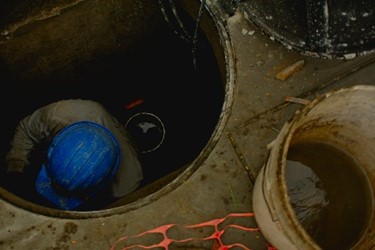Minnesota Governor Drops Into Sewer To Promote $300M Infrastructure Plan


Among the obstacles that prevent municipalities from upgrading outdated drinking water, wastewater, and stormwater infrastructure are lack of funds and the need to raise public awareness about the issue. Earlier this month, the governor of Minnesota made an attention-grabbing effort to overcome both in Minneapolis.
“Gov. Tim Walz went into a storm sewer … to call attention to his proposal for Minnesota to borrow $300 million to protect its water supplies by replacing aging infrastructure and upgrading treatment facilities,” the Star Tribune reported. “Wearing a yellow hardhart and a safety harness, Walz stepped into a metal basket and was lowered down a 90-foot shaft to learn firsthand what city officials deal with when it comes to clearing stormwater from the streets.”
As in many communities across the country, Minneapolis’ storm sewer system is old and failing. According to the report, some parts were installed 100 years ago and now leak, destabilizing ground beneath the city. And some tunnels are too small to handle the record-setting rainfalls that are now becoming standard, which can lead to undue pressure and flooded streets.
Walz’s journey into the sewer was an effort to promote a larger, $2 billion bonding bill that will borrow money for several public works initiatives, including affordable housing and higher-education facilities. But the second of the four-installment plant is dedicated to the water system.
“The Democratic governor’s water package is part of what he says will be around a $2 billion borrowing proposal, also known as a bonding bill,” according to KROC. “It’s aimed at helping communities clean up existing contamination and upgrade facilities to prevent pollution from happening.”
While the field trip successfully drew attention to Minneapolis’ infrastructure issues, it’s still not clear whether Walz will be able to secure the funds he wants to fix it. That will be determined by the state legislature.
“The House Democratic majority is expected to offer a plan as big as $3.5 billion in the coming weeks, while Republican Senate Majority Leader Paul Gazelka said … that he’d be more comfortable with a bonding bill in the range of the last two, which totaled $825 million and $998 million,” according to the Star Tribune.
To read more about how local lawmakers raise funds for drinking water, wastewater, and stormwater infrastructure, visit Water Online’s Funding Solutions Center.
